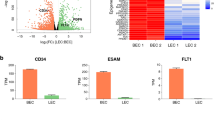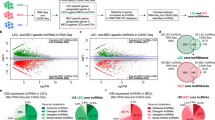Abstract
Recent single-cell RNA sequencing studies in mouse and human have clearly indicated that lymphatic endothelial cells (LECs) consist of multiple cell subsets, each expressing a unique set of genes, residing in distinct locations in the body. These studies have also revealed a conserved pattern of gene expression in LECs across animal species, as well as specialized sets of genes unique to each species. However, the extent to which this heterogeneity is adaptive to the external milieu surrounding LECs has remained unclear. The transcriptional and regulatory pathways that program the different subsets of LECs also remain unexplored.
Similar content being viewed by others
Main text
Recent studies using single-cell transcriptomics of lymphatic endothelial cells (ECs) (LECs) have unambiguously shown that these cells are not just a homogeneous group of cells lining a conduit for fluid and cells, but actually consist of multiple cell subsets [1,2,3,4] that together serve a variety of physiological functions in different tissues. These functions include regulating lymphocyte/dendritic cell egress from {5] and ingress into lymph nodes [6, 7], antigen presentation [8], tolerance induction [9], and transport of lipoproteins and chylomicrons [10]. LECs are clearly active players in major physiological processes.
However, several issues concerning the previously described endothelial heterogeneity remain unclear. First, it remains unclear how these phenotypic differences between LEC subsets contribute to specific functions of lymphatic vessels. Second, we do not know how these differences are established and maintained. Given that endothelial cells are plastic and can adopt subtly different phenotypes in response to environmental stimuli, these phenotypic differences are likely to be governed at least in part by differences in the extracellular milieu. Because endothelial cells have the ability to sense and respond to their environment, the diversity of micro-anatomical signals between one region and the next may contribute to the generation of phenotypic heterogeneity within a tissue. As indicated by Lee et al. [11], plasticity is likely to be the main mechanism that enables heterogeneity. It also remains unclear to what extent these phenotypic differences are fixed. The relative contributions of epigenetic and non-epigenetic influences to the phenotypic heterogeneity need to be elucidated.
The results from recent studies on LEC heterogeneity using single-cell RNA sequencing (scRNA-seq) of lymph node-derived LECs in human and mouse are summarized in Table 1. A study by Takeda et al. [1] investigated the heterogeneity of human LN lymphatics by scRNA-seq of LECs isolated from surgically excised fresh axillary LNs, as well as head and neck LNs, identifying six types of LEC (LEC I–LEC VI). Interestingly, these LEC subtypes are not only transcriptionally different from each other but also located in different anatomical sites, as shown in Table 1. For instance, LEC1 is found in the ceiling of the subcapsular sinus and expresses CCRL1, which encodes the chemokine receptor CCRL1 (chemokine C-C motif receptor-like protein-1) or the atypical chemokine receptor ACKR4 (atypical chemokine receptor 4) that internalizes and thus scavenges the homeostatic chemokines CCL19, CCL21, and CCL25 in situ. Because these homeostatic chemokines are involved in regulating immune cell trafficking within LNs, the LEC I subset is likely to be involved in the regional regulation of immune cell trafficking. In contrast, LEC II is selectively found in the floor of the subcapsular sinus and expresses CCL20, which recruits innate-like lymphocytes to this region. LEC III is found in the LN capsule ceiling overlying the medulla. LEC IV is found in the head and neck LNs, but not in the axillary LNs. LEC V is found preferentially in the lymphatic valve, and LEC VI is selectively found in the medulla.
Studies using mice have also identified five to six different LEC subsets, as summarized in Table 1. Apart from those identified in humans [1], one study [2] found an LEC subset that covers the inner surface of the cortical to medullary sinuses, preferentially expressing Lyve1, CCL21a, and Ptx3. Judging from its gene expression profile and anatomical location, this subset appears to be identical to the LEC subset implicated in rapid lymphocyte egress from LNs [3].
Clearly, further study is required to functionally delineate these LEC subsets. In addition, their ontogeny, the lineages among these subsets, and the molecular requirements for the development of these subsets also remain to be studied.
Conclusions
In summary, while a number of LEC subsets have been defined in lymph nodes on the basis of their gene expression patterns and anatomical locations, further investigation is required to fully understand their physiological and pathological roles in lymphoid tissues. It would also be interesting to examine how infections, cancer, and other diseases affect LEC heterogeneity in lymphoid tissues.
Availability of data and materials
Not applicable
Abbreviations
- LEC:
-
Lymphatic endothelial cell
References
Takeda A, Hollmén M, Dermadi D, Pan J, Brulois KF, Kaukonen R, et al. Single-cell survey of human lymphatics unveils marked endothelial cell heterogeneity and mechanisms of homing for neutrophils. Immunity. 2019;51(3):561–572.e5. https://doi.org/10.1016/j.immuni.2019.06.027.
Xiang M, Grosso RA, Takeda A, Pan J, Bekkhus T, Brulois K, et al. A single-cell transcriptional roadmap of the mouse and human lymph node lymphatic vasculature. Front Cardiovasc Med. 2020;7:52. https://doi.org/10.3389/fcvm.2020.00052.
Fujimoto N, He Y, D’Addio M, Tacconi C, Detmar M, Dieterich LC. Single-cell mapping reveals new markers and functions of lymphatic endothelial cells in lymph nodes. PLos Biol. 2020;18(4):e3000704. https://doi.org/10.1371/journal.pbio.3000704.
Sibler E, He Y, Ducoli L, Keller N, Fujimoto N, Dieterich LC, et al. Single-cell transcriptional heterogeneity of lymphatic endothelial cells in normal and inflamed murine lymph nodes. Cells. 2021;10(6):1371. https://doi.org/10.3390/cells10061371.
Pham TH, Baluk P, Xu Y, Grigorova I, Bankovich AJ, Pappu R, et al. Lymphatic endothelial sphingosine kinase activity is required for lymphocyte egress and lymphatic patterning. J Exp Med. 2010;207(1):17–27. https://doi.org/10.1084/jem.20091619.
Randolph GJ, Sanchez-Schmitz G, Angeli V. Factors and signals that govern the migration of dendritic cells via lymphatics: recent advances. Springer Semin Immunopathol. 2005;26(3):273–87. https://doi.org/10.1007/s00281-004-0168-0.
Weber M, Hauschild R, Schwarz J, Moussion C, de Vries I, Legler DF, et al. Interstitial dendritic cell guidance by haptotactic chemokine gradients. Science. 2013;339(6117):328–32. https://doi.org/10.1126/science.1228456.
Vokali E, Yu SS, Hirosue S, Rinçon-Restrepo M, V. Duraes F, Scherer S, et al. Lymphatic endothelial cells prime naïve CD8+ T cells into memory cells under steady-state conditions. Nat Comm, 2020; 11:538, 1, doi: https://doi.org/10.1038/s41467-019-14127-9.
Tewalt EF, Cohen JN, Rouhani SJ, Guidi CJ, Qiao H, Fahl SP, et al. Lymphatic endothelial cells induce tolerance via PD-L1 and lack of costimulation leading to high-level PD-1 expression on CD8 T cells. Blood. 2012;120(24):4772–82. https://doi.org/10.1182/blood-2012-04-427013.
Randolph GJ, Miller NE. Lymphatic transport of high-density lipoproteins and chylomicrons. J Clin Invest. 2014;124(3):929–35. https://doi.org/10.1172/JCI71610.
Lee S, Choi I, Hong YK. Heterogeneity and plasticity of lymphatic endothelial cells. Semin Thromb Hemost. 2010;36(03):352–61. https://doi.org/10.1055/s-0030-1253457.
Acknowledgements
I thank Edanz (https://jp.edanz.com/ac) for editing the English text of a draft of this manuscript.
Funding
Not applicable
Author information
Authors and Affiliations
Contributions
MM wrote the manuscript. The author read and approved the final manuscript.
Corresponding author
Ethics declarations
Ethical approval and consent to participate
Not applicable
Consent for publication
Not applicable
Competing interests
The author declares no competing interests.
Additional information
Publisher’s Note
Springer Nature remains neutral with regard to jurisdictional claims in published maps and institutional affiliations.
Rights and permissions
Open Access This article is licensed under a Creative Commons Attribution 4.0 International License, which permits use, sharing, adaptation, distribution and reproduction in any medium or format, as long as you give appropriate credit to the original author(s) and the source, provide a link to the Creative Commons licence, and indicate if changes were made. The images or other third party material in this article are included in the article's Creative Commons licence, unless indicated otherwise in a credit line to the material. If material is not included in the article's Creative Commons licence and your intended use is not permitted by statutory regulation or exceeds the permitted use, you will need to obtain permission directly from the copyright holder. To view a copy of this licence, visit http://creativecommons.org/licenses/by/4.0/.
About this article
Cite this article
Miyasaka, M. A short review on lymphatic endothelial cell heterogeneity. Inflamm Regener 41, 32 (2021). https://doi.org/10.1186/s41232-021-00183-6
Received:
Accepted:
Published:
DOI: https://doi.org/10.1186/s41232-021-00183-6




